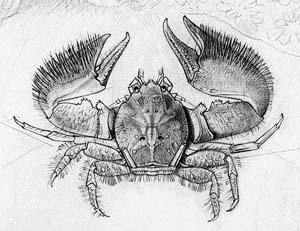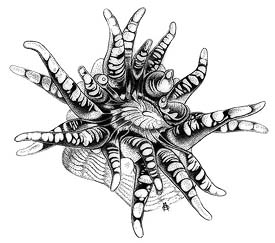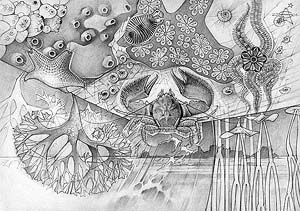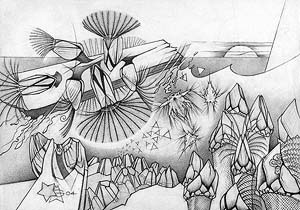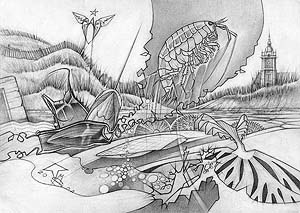Drawing
|
During my childhood I liked going to the seashore to the marvellous natural coast of the North Finistère in Brittanny, France. When I was very young I discovered for the first time a little starfish in a small pool. I still remember the image of this cushion-star that moved very slowly. Since that day, the sea and its universe became a real attraction for me, a true land of discovery. Later I studied marine biology at the University of Brest. Nowadays I continue to be fascinated by sea animals, especially invertebrates, by working in Oceanopolis, an Aquarium in Brest. Marine invertebrates look like extraterrestrial creatures. They live in another world,in another scale, nevertheless they were on our planet long before us. |
For the drawings presented in this article, I collected animals in nature and I drew them by observing them alive under a binocular microscope or through a magnifying glass. The sea anemone represented here is a "stone precious anemone" called Bunodactis verrucosa. She has striped tentacles and lives in a little pool or under the stones. This drawing is made with china ink by doing points with pen and Rotring 0.1mm. All other drawings are made with grey and graphite pencils from 2H to 9B. With these materials, very precise lines can be made, but also just suggestions, sketches, transformed or exaggerated. I also never draw without a special kneadable eraser which helps to refine details. I put a part of my imagination in these drawings and I also like to add some secrets in my landscapes; so that, finally the universe represented appears unreal or a little fantastic. |
I spend many days on a drawing. They mature slowly and in the end I get the impression to be in the landscape among the animals. Let's dive under and find out everything about “the life under a stone”. |
| A good way to find marine organisms is to look under the stones. There, many zoological groups are represented: Sponges, Cnidaria, Annelids, Bryozoa, Molluscs, Arthropods, Echinoderms, Tunicates (ascidians). Life around the stone is a real ecosystem. Many species like sponges and ascidians, unable to move must live in a wet atmosphere, sheltered from the light. These fixed animal have to filter water at high tide to collect little particles like small plankton in an internal cavity by creating a current with cilia. |
|
Barnacles
are inhabitants of the upper zones of the exposed shore. They
encrust stones and shells by producing a cement and take place
of algae which can't withstand the strong and heavy waves. On some
cliffs in the Brest Channel, we find another species of cirripedes:
the rock-goose barnacle solidly attached on the rock by a peduncular
cover of tiny scales. The top of this strange animal is protect
by two valves made of several calcarean plates. Fixed on floating
objects like a piece of wood they
often wash up on the beach. We can
say that the life of these 'poor' animals
depends on the current as many animals fixed on algae on the shore. |
|
It's always a real pleasure to walk along the high of the shore on the high water mark ("laisse de mer" in French). We can sometimes find objects which have made a long travel, often plastic matter but also interesting organic remains. It’s something like treasure hunting. Comments to the author Michel Salaün are welcomed! |
see more examples of small marine organisms in Wim van Egmond's article: Hidden life in tide pools
all images © Michel Salaün 2004
